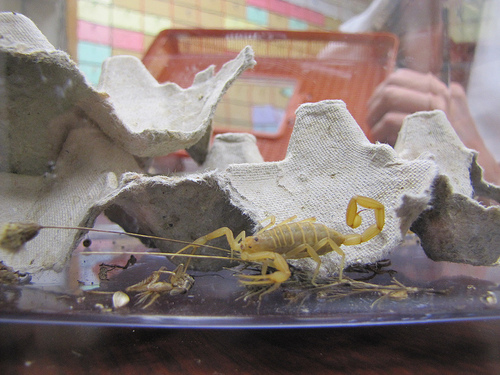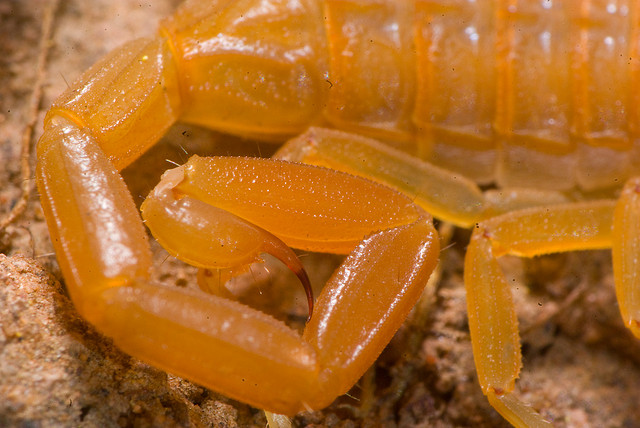Nutrition
Obtaining Food
Centruroides sculpturatus is a nocturnal species, so it comes out at night to hunt. It kills its food with the process of paralysis from venom found in its tail, and then grabbing it with its pedipalps and digging in. Scorpion tails are long and coiled, with a venomous barbed tip which is used to strike prey. C. sculpturatus will sit still and hide, becoming virtually invisible in the dark, and wait for insects or other prey to come along. These scorpions utilize fine hairs on their legs and pectines, which are located on their underside, to sense prey. Pectines are comb-like sensory organs which come in contact with the ground and feel vibrations.
Photo credit Fronteras Desk
Food Source
Arizona Bark Scorpions generally feed on cockroaches, crickets, moths, spiders and other invertebrates that occupy riparian habitats. When one of these food items passes by, C. sculpturatus will ambush it and grab it with its claws and strike it with its venomous tail. Some scorpions may just use their grabbing claws in certain scenarios to kill food, but since C. sculpturatus is characterized by weak pedipalps and very potent venom, a sting with its tail is most often utilized as the source of attack.
Photo credit Jasper Nance
Winter
Scorpions generally eat several times a week when food sources are abundant. During the winter, C. sculpturatus has been found to go months without eating because of harsh conditions and a scarce food supply. These scorpions actually in a sense "hibernate" in large groups up to 40 during this time to wait out the winter months.
Photo credit Chris Barker
Circulatory System
As part of the phylum Arthropoda, C. sculpturatus has an open circulatory system which is used as a means to transport oxygen and nutrients within its body. An open circulatory system is different from what humans have, which is a closed circulatory system. Open circulatory systems are comprised of a heart, vessels, a hemocoel, and hemolymph. Vessels travel to and from the heart, the hemocoel is the cavity that surrounds the organs, and hemolymph is the fluid which brings materials and nutrients around the system. The scorpions organs are basically submerged in hemolymph in order to acquire sufficient oxygen and nutrient supply. Muscular movements help transport the hemolymph around the body.
Learn about the reproduction of C. sculpturatus!
Get back to the main page by clicking here!



